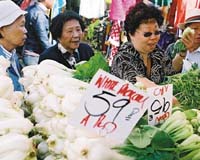 |
Gaillac, France (AFP) Dec 24, 2010 Bernard Plageoles' eyes flash with anger as he describes a largely futile 30-year struggle to dissuade fellow vintners from ripping up the now rare grape varietals that once defined this historic wine region. Four decades ago, the rolling vineyards of Gaillac, in southwestern France, were laden with distinctive grapes even ardent wine lovers have probably never heard of: mauzac noir, prunelard, l'ondenc, duras, loin-de-l'oeil. The last of these translates as "far-from-sight," and that's where these ancient varietals are today. By the early 1990s, many had virtually disappeared, torn from their native soil and replaced with the handful of grapes made famous in the legendary vineyards of Bordeaux, Burgundy and the upper Rhone Valley. "We were told that we would never be able to raise the quality of our wines with indigenous varietals," recalled Plageoles. "Winemakers thought they were doing the right thing by switching. Today, we see that it was a mistake, because you find these other grapes everywhere." The loss has been especially painful in Gaillac, where a once-illustrious wine past stretches back more than 1,000 years. But the same trend toward standardisation has cropped up all over France. The 10 most common grapes that today cover 70 percent of the country's vineyards only accounted, in 1960, for about 12 percent of the total surface planted in vines. The conquest of these globalised varietals -- mainly merlot, grenache, cabernet, syrah in red, along with chardonnay and sauvignon in white -- has been even more complete in New World vineyards from Australia to South Africa to California. At the same time, dozens upon dozens of lesser known grapes in France, some with tremendous taste potential, were allowed to wither on the vine. "There are nearly 400 distinct varietals catalogued," said Pascal Bloy, who oversees living specimens of each at the French Institute for Vineyards and Wine, a national conservatory near Montpellier. "Most of the secondary ones have progressively disappeared since World War II," he told AFP during a tour of the Institute, where vines are planted in sterile, seaside sand to protect against disease. But Plageoles and a small band of like-minded advocates of what the French call "vieux cepages," or old varietals, are leading a revival of these forgotten grapes in Gaillac, and winemakers in other regions are doing the same. -- Heritage worth saving -- --------------------------- Different forces drive the trend, which is unfolding under the sceptical eye of France's more conservative vintners and powerful wine bureaucracy. "The challenge of helping to restore grape varieties at risk of vanishing altogether is very motivating," said Patrice Lescarret, a self-described maverick whose intense, original wines at his Cause Marines winery score high praise from critics. "There is a genuine heritage here -- both cultural and biological -- worth saving." Gaillac's retro-rebels are also searching for tastes "beyond the standard palette of buttery Chardonnays and over-oaked cabernets," Lescarret said. One varietal in particular, prunelard, has emerged as a star that could, one day, become Gaillac's signature wine. Once the region's dominant red-wine grape, prunelard had become so rare by the time Bernard Plageoles's father Robert -- the pioneer, by several accounts, of the old varietal movement -- decided 20 years ago to plant it that none could be found. Starting with cuttings from a single vine tracked down at a regional conservatory, the area under cultivation has today expanded to nearly 10 hectares spread across half-a-dozen properties. "The gustatory qualities surpassed our wildest expectations," said Michel Issaly, whose first act upon taking over his family estate, Domaine de la Ramaye, in the early 1990s was to remove all the "foreign" vines. "It produces magnificent wines -- concentrated, balanced, velvety, with a tremendous ageing potential," he said. Issaly, president of France's largest association of independent winemakers, said it is market potential that ultimately will sway other less adventurous winemakers. "Working with the old varietals allows us to bring an added value to the market, to create a wine that you can't find anywhere else," he explained. Confronted with a shrinking domestic demand and intense competition abroad, many producers from unheralded wine regions in France are barely getting by. For Bernard Plageoles, the growing interest in France's neglected grapes vindicates years of difficult, sometimes acrimonious, struggle. "They looked upon my dad as the village idiot," he said, recalling how his father, then head of the producers association, was eased aside by fellow wine growers uncomfortable with his cause. "But 30 years later Gaillac is beginning to realise that we have to return to these local varietals. Better late than never," he said with a shrug and a smile.
Share This Article With Planet Earth
Related Links Farming Today - Suppliers and Technology
 Price rises highlight China food supply challenges: UN envoy
Price rises highlight China food supply challenges: UN envoyBeijing (AFP) Dec 23, 2010 Recent food price surges in China have underscored the supply challenges the country faces, as decreasing arable land is making it harder to maintain farm output, a UN envoy said Thursday. Massive land degradation is another factor hindering agricultural yields in the world's most populous nation, Olivier De Schutter, the UN special rapporteur on the right to food, said as he wrapped up a vi ... read more |
|
| The content herein, unless otherwise known to be public domain, are Copyright 1995-2010 - SpaceDaily. AFP and UPI Wire Stories are copyright Agence France-Presse and United Press International. ESA Portal Reports are copyright European Space Agency. All NASA sourced material is public domain. Additional copyrights may apply in whole or part to other bona fide parties. Advertising does not imply endorsement,agreement or approval of any opinions, statements or information provided by SpaceDaily on any Web page published or hosted by SpaceDaily. Privacy Statement |